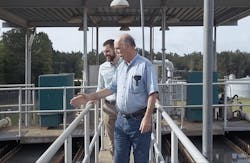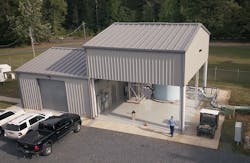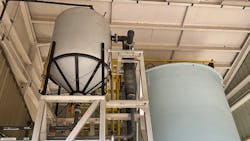Plant solves DOC, chlorine residuals with dual pre-treatment approach
Like many water treatment plants throughout the country, officials at DeSoto Waterworks District 1, DeSoto Parish, Louisiana, faced the challenge of how to effectively manage dissolved organic carbon. When the organic matter inherent in source water reacts with a plant’s disinfectant, the resulting disinfection by-products (DBPs) can create health risks. In Louisiana, there was another equally challenging issue: managing the Naegleria fowleri parasite, which requires high doses of disinfectant to control.
For John Neilson, administrator of Waterworks District 1, these dueling challenges required a new and innovative solution beyond expensive chemical treatments. The solution, he discovered, delivered better results than he hoped for. A magnetic ion exchange process from Ixom Watercare used for pretreatment allows the plant to efficiently meet its disinfection requirements, while reducing operating costs and delivering consistently high-quality water for the district’s customers.
“There are a lot of ways to get rid of disinfectant by-products,” said Neilson, “but our goal was to find a process where we don’t create disinfectant by-products.”Compliance with requirements
Located in northwestern Louisiana near Shreveport, DeSoto Parish consists of 14 waterworks districts. Waterworks District 1, with a 1 million gallon-per-day capacity, sources its water from the Toledo Bend Reservoir, a shallow reservoir of approximately 186,000 acres. District 1 is currently bidding to expand its capacity to two million gallons a day, due to increased residential and commercial use.
While a typical system of this size may have 20 to 30 miles of pipeline distributing water, Waterworks District 1, in contrast, distributes potable water throughout 300 miles of pipeline and 2,300 connections to about 5,000 customers in rural, widespread areas of DeSoto Parish
“This comes with its own challenges, especially in this era of high regulations and disinfection by-products” Neilson said.
In water systems with natural organic matter content (NOM), including dissolved organic carbon (DOC), disinfectant added at the treatment facility, whether chloramine or chlorine, can react with NOM to form DBPs. The U.S. EPA’s Stage 2 Disinfectants and Disinfection By-Products Rule (DBPR) requires water treatment plants to monitor for two types of disinfection by-products in drinking water: total trihalomethanes (TTHMs) and haloacetic acids (HAAs).
TTHMs and HAAs have been shown to cause negative human health effects such as cancer and reproductive harm. As a result, plants must provide quarterly water quality samples that show amounts no greater than 80 parts per billion for TTHMs, and 60 parts per billion for HAAs.
In 2013, the state of Louisiana established the Disinfection Emergency Rule in response to documented cases of drinking water contaminated with the Naegleria fowleri parasite. DeSoto Parish had witnessed the ravaging effects of the parasite while also using ammonia. The rule requires all water treatment plants, including DeSoto’s District 1, to increase disinfection residual levels from 0.2 to 0.5 milligrams per liter at the terminal site of their distribution system.
The district utilizes a chloramine-based disinfection system. The goal of this system is to create and maintain equal parts chlorine and ammonia, or monochloramine, to maximize residual disinfection and minimize DBP formation.
With the potential development of nitrification, this can be difficult to get right. If nitrification occurs, ammonia levels decrease and chlorine levels increase, leading to a higher potential of DPB formation and lower levels of residual disinfection. For District 1, this could impair their ability to meet regulations standards for both the Stage 2 DBPR and the Louisiana State Disinfection Emergency Law.
The district’s source water reservoir has a total organic carbon (dissolved organic carbon and natural occurring organic matter), or TOC, of around 10 mg/L. With higher levels of organics, higher concentrations of chloramines both in amount and frequency are required to achieve proper residual disinfection.
Treating the water with alum coagulation ranged in effectiveness from 35% to 70% depending on the season. Iron and manganese issues could become significant with a few hours’ notice — and the district had already invested in membrane filtration, not to mention significant expenditure for chlorine dioxide, caustic, and ammonia, to provide its citizens with the best drinking water possible.
Neilson was convinced that the best way to avoid many of the pitfalls of chloramination — nitrification, poor tasting and smelling water, and the growth of Naegleria fowleri — was to convert back to free chlorine. The challenge was how to reduce the organics even further, so that free chlorine could be used without violating EPA’s DBPR requirement.Trying something new
With the need to meet Stage 2 DBPR and Louisiana state Disinfection Emergency Rule, Neilson contacted Benjamin Rauschenbach, an engineer with Manchac Consulting Group in Baton Rouge. Rauschenbach then connected Neilson with Ixom Watercare.
The district partnered with Ixom Watercare to implement the company’s magnetic ion exchange (MIEX) system.
MIEX is a small-particle resin that is fluidized and used as a pretreatment step to pull organics from untreated water before it reaches the plant. This pretreatment removes dissolved organic carbon, thereby reducing disinfection by-product formation.
The magnetic property of these resin beads allows them to agglomerate and settle rapidly, or fluidize, at high hydraulic loading rates. Because of this feature, it is used in a continuous process with ion exchange occurring in either a mixed tank or a fluidized bed reactor vessel.
Since implementation, District 1 reduced incoming organic loads, lowering chloramine dosing and the likelihood of DBP formation.
The system also helps resolve coagulation issues and improve membrane performance.
Increased water demand had outpaced the district’s flocculation and sedimentation basins and, as a result, a large volume of solids regularly escaped the sedimentation basins and landed on the surface of their membrane filters. While the membranes were able to handle the load, the result was continuous backwashing of the membranes, and a cleaning regime that was onerous.
After the pre-treatment, the floc improved in size, structure and ability to settle out in the existing sedimentation basins at the flow required by the utility. In effect, the pretreatment allowed operators to “high rate” their existing flocculation and sedimentation process, which resulted in a longer membrane run time and fewer cleanings.
Depending on the season, this pretreatment can offer as much as 35% additional DOC reduction when compared to chlorine dioxide/alum/caustic.
Prior to the pretreatment solution, the alum doses at the district were between 150 and 220 mg/L, with chlorine dioxide doses in summer of up to 8 mg/L, as well as chlorine and ammonia. Chemical costs were high. Afterward, the alum dose has been reduced by 50%, no chlorine dioxide is utilized, and ammonia has been turned off.
“We have half of the DBP levels that we previously had,” said Neilson. “We have twice the chlorine residuals in the system that we previously had, while using less than half of the chemicals that we used prior to the MIEX pre-treatment.”
The next step: mixing
With reduction in DBP levels, District 1 was able to move to a free chlorine system, eliminating ammonia altogether while staying within compliance.
“We were doing OK on just straight chlorine,” said Neilson. “MIEX got us down under the limit. But we were right on the edge, so we decided to go back to a chloramine system as a cushion in case we had any kind of upset.”
Reintroducing ammonia set District 1 outside of their regulation parameters, and that led them to the next step in their water treatment plan: adding mixing.
“Our widespread distribution system contributes to our DOC problem,” said Neilson. “Our retention time is about seven days; 12 to 13 days during the winter. Even if you start out with a low level of THMs, that doesn’t solve the problem if, due to the presence of DOC and long retention times in the system, THMs continue to form out in the distribution system. MIEX has helped; but we needed to add mixing.”
To maintain residuals from the treatment plant, the district installed another Ixom product: GridBee GS 9 submersible mixers in each ground storage tank on site.
The GS mixers are designed to relieve stagnation and stratification, while aiding in maintaining consistent residual levels. In addition to the ground storage tanks, District officials added GridBee mixers to four elevated tanks in distribution.
According to Neilson, this has eliminated the need for chloramine dosing beyond the plant while remaining compliant with DBPR regulations. In addition to aiding residual levels, the mixers, in effect, scrub the tanks.
“Free chlorine is reaching parts of the distribution system which haven’t seen free chlorine in years,” said Neilson. “With GridBee, we don’t allow water to age in tanks. Water is continually turned over.”
After both stages, the TTHM levels decreased to 21 parts per billion (ppb) from an average of 65 ppb. HAA5 levels dropped to 12 ppb from an average of 50 ppb.
“Before mixing, the water in the tanks would settle out, and appear dark when we drained the tanks” said Neilson, “possibly from manganese settling out. Now with the mixers installed, the water is crystal clear when drained, and looks the same as freshly treated water. And we have had no manganese complaints this year. With mixing, water doesn’t have a chance to settle out.”
Despite tight regulations on DBPs and higher residual disinfection requirements, Neilson and his team’s persistent pursuit provides safe drinking water for DeSoto Parish. WW







